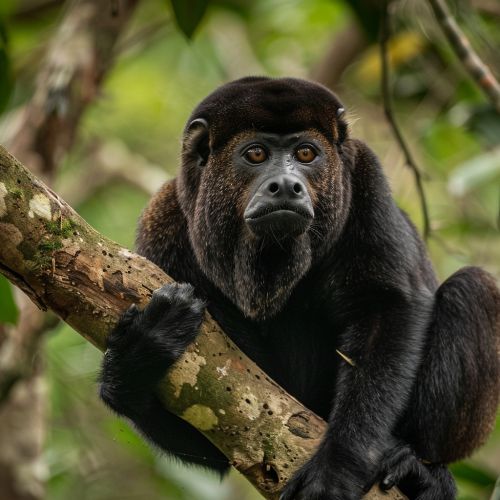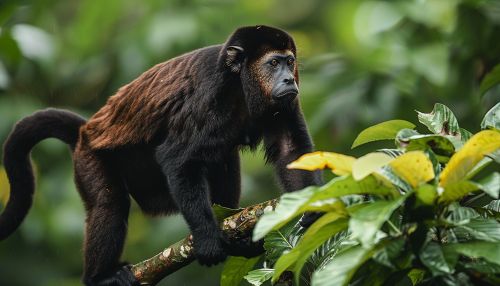Howler Monkey: Difference between revisions
(Created page with "== Introduction == The Howler Monkey (genus: Alouatta) is a member of the New World monkeys and is known for its distinctive vocalizations, which can be heard over considerable distances. These primates are native to Central and South America and are among the largest of the New World monkeys. Howler monkeys are an essential component of their ecosystems, playing significant roles in seed dispersal and forest dynamics. == Taxonomy and Evolution == Howler monkeys b...") |
No edit summary |
||
| Line 15: | Line 15: | ||
The vocal apparatus of howler monkeys is highly specialized. The enlarged hyoid bone acts as a resonating chamber, amplifying their calls. These vocalizations serve multiple purposes, including territory defense, mate attraction, and group cohesion. The calls can be heard up to 5 kilometers away, making them one of the loudest land animals. | The vocal apparatus of howler monkeys is highly specialized. The enlarged hyoid bone acts as a resonating chamber, amplifying their calls. These vocalizations serve multiple purposes, including territory defense, mate attraction, and group cohesion. The calls can be heard up to 5 kilometers away, making them one of the loudest land animals. | ||
[[Image:Detail-91447.jpg|thumb|center|A howler monkey perched on a tree branch in a dense forest, showcasing its prehensile tail and robust build.|class=only_on_mobile]] | |||
[[Image:Detail-91448.jpg|thumb|center|A howler monkey perched on a tree branch in a dense forest, showcasing its prehensile tail and robust build.|class=only_on_desktop]] | |||
== Behavior and Social Structure == | == Behavior and Social Structure == | ||
Latest revision as of 05:41, 21 June 2024
Introduction
The Howler Monkey (genus: Alouatta) is a member of the New World monkeys and is known for its distinctive vocalizations, which can be heard over considerable distances. These primates are native to Central and South America and are among the largest of the New World monkeys. Howler monkeys are an essential component of their ecosystems, playing significant roles in seed dispersal and forest dynamics.
Taxonomy and Evolution
Howler monkeys belong to the family Atelidae, which also includes spider monkeys, woolly monkeys, and woolly spider monkeys. The genus Alouatta is composed of several species, each adapted to specific ecological niches within their geographical range. The evolutionary history of howler monkeys is closely linked to the diversification of the New World monkeys, which is believed to have occurred around 40 million years ago.
Anatomy and Physiology
Howler monkeys are characterized by their robust build, prehensile tails, and enlarged hyoid bones, which facilitate their loud vocalizations. Their fur color varies among species, ranging from black to brown to reddish. The prehensile tail is a critical adaptation for their arboreal lifestyle, allowing them to grasp branches and navigate the forest canopy with ease.
Vocalization
The vocal apparatus of howler monkeys is highly specialized. The enlarged hyoid bone acts as a resonating chamber, amplifying their calls. These vocalizations serve multiple purposes, including territory defense, mate attraction, and group cohesion. The calls can be heard up to 5 kilometers away, making them one of the loudest land animals.


Behavior and Social Structure
Howler monkeys are social animals, typically living in groups ranging from 6 to 15 individuals. These groups usually consist of multiple males and females, along with their offspring. Social hierarchies are established through vocal displays and physical interactions.
Diet
Howler monkeys are primarily folivorous, feeding on a variety of leaves, fruits, and flowers. Their diet is highly specialized, and they have evolved a digestive system capable of breaking down tough plant material. This diet provides them with the necessary nutrients but also requires them to spend a significant amount of time resting to aid digestion.
Reproduction
Reproductive strategies in howler monkeys involve both polygynous and promiscuous mating systems. Females typically give birth to a single offspring after a gestation period of around 6 months. The young are highly dependent on their mothers for the first year of life, during which they learn essential survival skills.
Habitat and Distribution
Howler monkeys inhabit a range of forest types, including tropical rainforests, cloud forests, and dry deciduous forests. Their distribution extends from southern Mexico through Central America to northern Argentina. They are highly adaptable and can thrive in both primary and secondary forests.
Conservation Status
The conservation status of howler monkeys varies by species. Some species, such as the black howler monkey (Alouatta caraya), are classified as Least Concern by the IUCN, while others, like the Yucatán black howler monkey (Alouatta pigra), are considered Endangered. Major threats include habitat loss, hunting, and disease.
Ecological Role
Howler monkeys play a crucial role in their ecosystems. As primary consumers, they influence plant community dynamics through their feeding habits. Additionally, their role as seed dispersers helps maintain forest diversity and regeneration. Their vocalizations also contribute to the acoustic landscape of their habitats, affecting the behavior of other species.
Research and Studies
Numerous studies have focused on the behavior, ecology, and physiology of howler monkeys. Research has provided insights into their social structures, communication systems, and adaptive strategies. Ongoing studies aim to understand the impacts of environmental changes on their populations and to develop effective conservation strategies.
